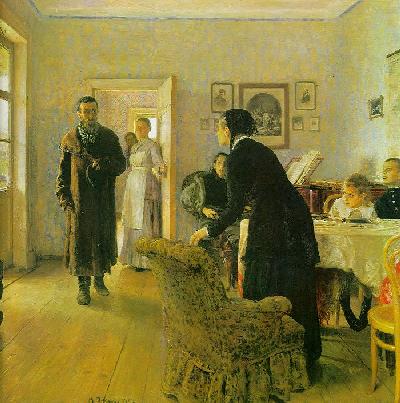Oil on canvas, 160.5 x 167.5 cm. Tretiakov Gallery, Moscow.
Oil on canvas, 160.5 x 167.5 cm. Tretiakov Gallery, Moscow.
 They Did Not Expect Him, one of Repin's best known works,
is considered by critics "the finest artistic achievement of the social
point of view of the Peredvizhniki" (Hamilton,
385). The painting shows a family surprised by an unexpected return of
a political exile home. In the first version of the painting, the exile
was a female; in the final version it is a male, a son, a husband, and
a father at the same time. To create his composition, Repin used his home
and the members of his family as models. Each person in the painting has
a different facial expression, captured very dramatically by the artist.
The exiled man, clutching his hat, hesitates in the middle of the room,
but instantly recognizes his mother. The old woman rises from her armchair,
and her figure projects a surprise and weakness at the same time. In the
back, at the piano, is the man's wife. Perhaps she is not certain who has
just entered the room; she smiles, but does not try to run to embrace her
husband. The little girl at the table looks at the figure suspiciously --
she does not know who it is because she is too young to remember her father.
But the boy sitting next to her recognizes him instantly and his face is
beaming. Two other figures, the maid at the door and the cook behind her,
also express their feelings. The cook is simply curious -- she wants to
discover who the man is and what is going to happen next. The maid is still
holding the door knob and her face is simultaneously polite (she is performing
her duties) and astonished. The composition can be divided into several
planes: the farthest is the kitchen window, followed by the figures of
the cook and the maid. The third plane includes the wall of the living
room and the woman at the piano. The fourth, most important plane encompasses
the figure of the man and the table with his children. The foreground is
occupied by the figure of the mother and her armchair. Notice, however,
how cleverly Repin places these two elements off center, allowing the viewer's
eyes to follow the direction of the floorboards and see the exiled man
immediately. Commenting on the composition, Hamilton suggests that the
"right-to-left direction in space, opposed by the sharpened perspective
drawing of the floorboards, is so suggestive of Degas that we can believe
that the lessons learned in Paris ten years before had at last come to
fruition" (385). The picture is full of light, which, despite the seriousness
of the topic and the work's obvious political overtones, makes this scene
joyous (the viewer can easily imagine that in a moment the room will be
filled with cries of joy, laughter, tears of happiness, and celebrations
of the return). [K.T. and A.B.]
They Did Not Expect Him, one of Repin's best known works,
is considered by critics "the finest artistic achievement of the social
point of view of the Peredvizhniki" (Hamilton,
385). The painting shows a family surprised by an unexpected return of
a political exile home. In the first version of the painting, the exile
was a female; in the final version it is a male, a son, a husband, and
a father at the same time. To create his composition, Repin used his home
and the members of his family as models. Each person in the painting has
a different facial expression, captured very dramatically by the artist.
The exiled man, clutching his hat, hesitates in the middle of the room,
but instantly recognizes his mother. The old woman rises from her armchair,
and her figure projects a surprise and weakness at the same time. In the
back, at the piano, is the man's wife. Perhaps she is not certain who has
just entered the room; she smiles, but does not try to run to embrace her
husband. The little girl at the table looks at the figure suspiciously --
she does not know who it is because she is too young to remember her father.
But the boy sitting next to her recognizes him instantly and his face is
beaming. Two other figures, the maid at the door and the cook behind her,
also express their feelings. The cook is simply curious -- she wants to
discover who the man is and what is going to happen next. The maid is still
holding the door knob and her face is simultaneously polite (she is performing
her duties) and astonished. The composition can be divided into several
planes: the farthest is the kitchen window, followed by the figures of
the cook and the maid. The third plane includes the wall of the living
room and the woman at the piano. The fourth, most important plane encompasses
the figure of the man and the table with his children. The foreground is
occupied by the figure of the mother and her armchair. Notice, however,
how cleverly Repin places these two elements off center, allowing the viewer's
eyes to follow the direction of the floorboards and see the exiled man
immediately. Commenting on the composition, Hamilton suggests that the
"right-to-left direction in space, opposed by the sharpened perspective
drawing of the floorboards, is so suggestive of Degas that we can believe
that the lessons learned in Paris ten years before had at last come to
fruition" (385). The picture is full of light, which, despite the seriousness
of the topic and the work's obvious political overtones, makes this scene
joyous (the viewer can easily imagine that in a moment the room will be
filled with cries of joy, laughter, tears of happiness, and celebrations
of the return). [K.T. and A.B.]
[Sources: Parker, Hamilton, Zotov].
